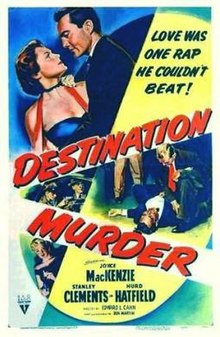Destination Murder
| Destination Murder | |
|---|---|
 Theatrical release poster | |
| Directed by | Edward L. Cahn |
| Screenplay by | Don Martin |
| Produced by |
|
| Starring | |
| Cinematography | Jackson Rose |
| Edited by | Philip Cahn |
| Music by | Irving Gertz |
Production company | Prominent Features Inc. |
| Distributed by | RKO Pictures |
Release date |
|
Running time | 72 minutes |
| Country | United States |
| Language | English |
Destination Murder is a 1950 American crime film noir directed by Edward L. Cahn. The drama features Joyce MacKenzie, Stanley Clements and Hurd Hatfield.
Plot[edit]
During a five-minute movie intermission, Jackie Wales leaves a theater, gets into a car, changes into a messenger's outfit, rings the doorbell of Arthur Mansfield, shoots him, then rushes back to the theater and his date.
After her father is shot, Laura Mansfield sees the killer hurdle the house's gate. At the police station, she looks at suspects in a lineup. One of them is Jackie, whom she chats with outside the station, not revealing who she is. Laura lets him drive her home, then sees Jackie hurdle the gate as her father's murderer did.
Police Lt. Brewster, the lead homicide investigator, ignores her tip and charges Arthur Mansfield's business competitor, Frank Niles, with the crime. Laura begins dating Jackie to keep an eye on him. He loses money gambling and goes to the Vogue nightclub to get a payoff from the men who run it. Instead, the boss, Armitage, brutally beats Jackie while the club's manager, Stretch Norton, starts the music of a player piano to drown out the noise.
Laura is frustrated by Brewster's seeming lack of action in solving her father's case. She takes a job as a cigarette girl at Vogue to learn more about Jackie's employer. Armitage and Stretch have a conversation, during which they reveal the fact that Niles hired Jackie to kill Mansfield. Alice Wentworth, a gold-digger whom Armitage loves but who flirts with Stretch, goes to Jackie with a plan: Write a letter confessing to the murder, implicating Armitage for hiring him, then get a $5,000 blackmail payment that Alice will split with him. The scheme works.
From the time they spend together, Laura ends up falling in love with Stretch and confessing her true identity. She does not realize that Stretch is the actual boss of the gang; Armitage works for him, as a front. Stretch persuades Alice to double-cross Jackie; she gives him Jackie's confession letter. Then Armitage starts the player piano, kills Alice, and burns Jackie's letter. Stretch also orders Armitage to kill Jackie on the way home.
Eliminating loose ends, Stretch drugs Armitage, puts a gun in his hand, and acts as if his partner is about to betray him, getting Laura to shoot Armitage. Brewster, regardless, does not believe the case is solved, and recruits Laura and Niles for a sting operation in Norton's office, with Niles offering to take Armitage's place. The recorded conversation implicates mastermind Norton. He attempts to take Laura hostage, but Brewster frees her and the two men fight. When Norton has the upper hand and is about to kill Brewster, police detective Mulcahy shoots and kills Norton.
Cast[edit]
- Joyce MacKenzie as Laura Mansfield
- Stanley Clements as Jackie Wales
- Hurd Hatfield as Stretch Norton
- Albert Dekker as Armitage
- Myrna Dell as Alice Wentworth
- James Flavin as Police Lt. Brewster
- John Dehner as Frank Niles
- Richard Emory as Police Sgt. Mulcahy
- Suzette Harbin as Harriet, Nightclub Maid
- Buddy Swan as Arthur, Blue Streak Messenger
- Bert Wenland as Dave, Blue Streak Messenger
- Franklyn Farnum as Arthur Mansfield, Laura's Father
- Steve Gibson and the Redcaps as Singing Group
Release and reception[edit]
Destination Murder was released June 6, 1950.[1]
Herb Rau, writing for The Miami News in 1950, called the premise ridiculous and the plot confused.[2] Much later, in a 2011 synopsis for the website AllMovie, critic Hans J. Wollstein agreed that the plot is baffling and attributed much of that confusion to important elements lacking in the screenplay:
In Destination Murder, former starlet Myrna Dell plays one of those hard-bitten, blonde schemers that no true film noir could be without. Unfortunately, both she and Stanley Clements, the only other interesting character in the film, are killed off fairly early on in the game. The result is a rather unsatisfying crime thriller where the "Why?" is more of a mystery than the "Who?" Unaccountably, screenwriter Don Martin completely fails to explain why Mansfield (Franklyn Farnum) was murdered, what business he was in, or how his death could in any way benefit the killer.[3]
Note: Screenwriter Don Martin is not the famed Mad cartoonist of the same name.
References[edit]
- ^ "Destination Murder: Detail View". American Film Institute. Retrieved May 18, 2014.
- ^ Rau, Herb (July 6, 1950). "At the Movies". The Miami News. Florida. p. 6B.
- ^ Wollstein, Hans J. "Destination Murder Synopsis". AllMovie. Archived from the original on July 12, 2012. Retrieved October 18, 2020.
External links[edit]
- Destination Murder at IMDb
- Destination Murder at the TCM Movie Database
- Destination Murder preview clip on YouTube (Warner Bros. Archive Collection)
